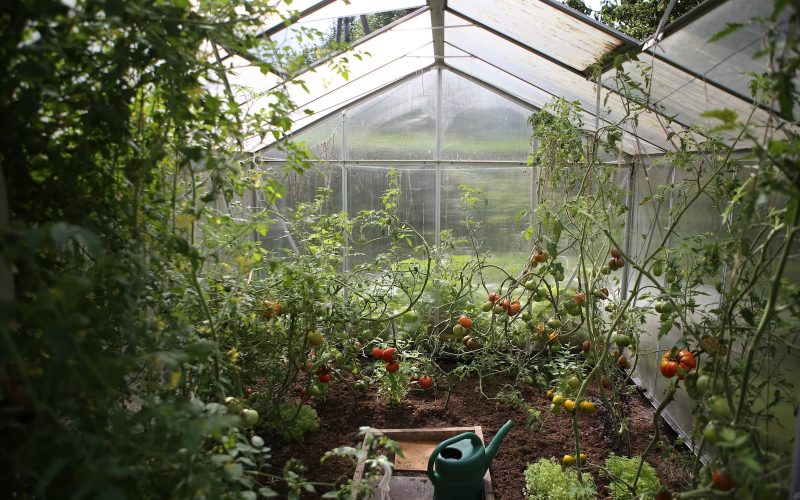When it comes to greenhouses, the choice of greenhouse plastic is a crucial factor that can greatly impact the success and longevity of your greenhouse.
Understanding the role and benefits of using greenhouse plastic is essential for any greenhouse owner.
Understanding the Role of Greenhouse Plastic
Greenhouse plastic serves as the primary covering material for your greenhouse structure.
It acts as a barrier that allows sunlight to enter the greenhouse while trapping heat inside, creating a controlled environment for your plants to thrive.
The transparent nature of greenhouse plastic allows for maximum light transmission, creating an ideal growing environment.
Not only does greenhouse plastic protect your plants from harsh weather conditions like wind, rain, and snow, but it also helps to create a stable microclimate within the greenhouse.
This controlled environment enables you to extend the growing season, cultivate a wider range of plants, and increase overall productivity.
To learn more about the fundamentals of greenhouses, check out our article on what is a greenhouse.
Benefits of Using Greenhouse Plastic
Greenhouse plastic offers several benefits, making it a popular choice among greenhouse owners.
Here are some key advantages:
- Cost-effective: Greenhouse plastic is generally more affordable compared to other greenhouse covering options such as glass or polycarbonate. This makes it an attractive choice, especially for those starting with a limited budget.
- Lightweight and easy to install: Greenhouse plastic is lightweight and easy to handle, making the installation process relatively straightforward. It can be secured to the greenhouse frame using clips, staples, or specialized fastening systems.
- Excellent light transmission: Greenhouse plastic provides exceptional light transmission, allowing your plants to receive the optimal amount of sunlight for photosynthesis. This is crucial for healthy plant growth and development.
- Versatility: Greenhouse plastic is available in different thicknesses and grades, allowing you to choose the one that suits your specific needs. Some plastics offer additional features such as UV protection or anti-condensation properties.
- Durability: While the lifespan of greenhouse plastic varies depending on various factors, high-quality plastic can provide several years of service. Routine maintenance and proper care can further extend its lifespan. For information on how to clean and maintain greenhouse plastic, check out our article on how to clean greenhouse plastic.
By understanding the role and benefits of greenhouse plastic, you can make an informed decision when choosing the right material for your greenhouse.
Remember to consider factors such as climate, durability, and your specific gardening needs when selecting greenhouse plastic.
For guidance on what type of plastic to use and where to purchase it, refer to our articles on what plastic to use for greenhouse and where to buy greenhouse plastic.
Factors Affecting the Lifespan of Greenhouse Plastic
When it comes to determining the lifespan of greenhouse plastic, several factors come into play.
Understanding these factors will help you make informed decisions about the type of plastic to use and how to best care for it.
The key factors that affect the lifespan of greenhouse plastic include the quality of the plastic material, exposure to sunlight and UV radiation, and climate and environmental conditions.
Quality of the Plastic Material
The quality of the greenhouse plastic material plays a significant role in its longevity. High-quality plastic is typically more durable and resistant to wear and tear.
Look for greenhouse plastic that is specifically designed for UV resistance and has a high strength rating.
Investing in a higher quality plastic material can help prolong the lifespan of your greenhouse covering.
Exposure to Sunlight and UV Radiation
Greenhouse plastic is constantly exposed to sunlight and UV radiation, which can cause degradation over time.
The intensity and duration of exposure to sunlight can vary depending on your geographical location and greenhouse position.
UV radiation can weaken the plastic, causing it to become brittle and prone to cracking.
To protect your greenhouse plastic from UV damage, consider using a UV-resistant coating or shade cloth to reduce direct sunlight exposure.
Regularly inspecting and replacing damaged or worn-out plastic is also essential to maintain the integrity of your greenhouse covering.
Climate and Environmental Conditions
The climate and environmental conditions in your area can significantly impact the lifespan of greenhouse plastic.
Extreme temperatures, high winds, heavy rainfall, and hailstorms can all contribute to the deterioration of the plastic material.
Harsh weather conditions can cause the plastic to become brittle, develop tears, or even completely fail.
If you live in an area with severe weather conditions, choosing a greenhouse plastic specifically designed to withstand these challenges is important.
Additionally, taking preventative measures such as reinforcing the structure, securing the plastic properly, and using additional protective layers can help mitigate the impact of adverse climate conditions.
By considering the quality of the plastic material, managing exposure to sunlight and UV radiation, and accounting for climate and environmental conditions, you can prolong the lifespan of your greenhouse plastic.
Regularly inspecting and maintaining your greenhouse covering will allow you to identify signs of deterioration and wear and take appropriate steps for repair or replacement.
For more information on greenhouse-related topics, check out our articles on what is a greenhouse and what is a greenhouse made of.
Typical Lifespan of Greenhouse Plastic
When it comes to greenhouse plastic, it’s important to understand its typical lifespan to ensure proper maintenance and replacement.
The lifespan of greenhouse plastic can vary depending on several factors, including the quality of the material, exposure to sunlight and UV radiation, and climate conditions.
Average Lifespan of Different Types of Greenhouse Plastic
The average lifespan of greenhouse plastic can range from 1 to 5 years, depending on the type of plastic used.
Here’s a breakdown of the typical lifespans for different types of greenhouse plastic:
| Type of Greenhouse Plastic | Average Lifespan |
|---|---|
| Polyethylene Film | 1 – 3 years |
| Polyvinyl Chloride (PVC) | 3 – 5 years |
| Polycarbonate Panels | 5 years or more |
Polyethylene film is the most common type of greenhouse plastic due to its affordability.
However, it has a shorter lifespan compared to other materials. PVC plastic offers a longer lifespan and increased durability.
Although more expensive, polycarbonate panels provide the longest lifespan and excellent resistance to impact and weather conditions.
It’s important to note that these lifespans are estimates and can vary depending on the specific brand, quality, and maintenance practices.
Regular inspection and maintenance can help prolong the lifespan of your greenhouse plastic.
Signs of Deterioration and Wear
Over time, greenhouse plastic may exhibit signs of deterioration and wear, indicating the need for replacement.
Here are some common signs to watch out for:
- Fading and Discoloration: Continuous exposure to sunlight and UV radiation can cause the plastic to fade and lose its original color.
- Brittleness and Cracking: As plastic ages, it may become brittle and develop cracks, compromising its structural integrity.
- Tearing and Ripping: Weakened plastic may tear or rip easily, especially during high winds or heavy rainfall.
- Loss of Transparency: Aged plastic may become cloudy or hazy, reducing the amount of light transmission into the greenhouse.
- Poor Insulation: Deteriorated plastic may no longer provide adequate insulation, leading to temperature fluctuations inside the greenhouse.
If you notice any of these signs, it’s time to consider replacing your greenhouse plastic to maintain optimal growing conditions for your plants.
Understanding the typical lifespan of greenhouse plastic and being aware of signs of deterioration and wear will help you plan for its replacement in a timely manner.
Regularly inspecting your greenhouse plastic and ensuring proper maintenance will help extend its lifespan and provide a conducive environment for your plants.
For more information on greenhouse care, check out our article on how to clean greenhouse plastic.
Extending the Lifespan of Greenhouse Plastic
To make the most of your greenhouse plastic and ensure its longevity, there are several steps you can take to extend its lifespan.
By focusing on proper installation, maintenance, and protective measures, you can maximize the durability of your greenhouse plastic.
Proper Installation and Maintenance
Proper installation is key to ensuring the longevity of your greenhouse plastic.
When installing the plastic, stretch it across the frame to minimize the risk of sagging or tearing.
Secure the plastic using appropriate fasteners that won’t damage the material.
Regular maintenance is also crucial. Keep the plastic clean by regularly removing dust, dirt, and debris.
This can be done by gently washing the plastic with a mild detergent and water. Avoid using harsh chemicals or abrasive materials that can damage the surface.
For more detailed instructions on cleaning greenhouse plastic, refer to our article on how to clean greenhouse plastic.
Routine Inspection and Repair
Regularly inspecting your greenhouse plastic for signs of wear and tear is essential. Look for any small tears, holes, or weak spots in the material.
These can be repaired using greenhouse repair tape or patches specifically designed for the purpose.
Promptly addressing any damage will prevent further deterioration and extend the lifespan of the plastic.
Protective Measures for Prolonged Durability
Protecting your greenhouse plastic from excessive UV radiation and harsh weather conditions can significantly prolong its durability.
Applying a UV protectant film or spray to the surface of the plastic can help mitigate the damaging effects of sunlight.
These protective coatings act as a barrier against UV radiation, reducing the risk of discoloration, brittleness, and premature degradation.
During extreme weather conditions, such as high winds or heavy snowfall, it’s advisable to reinforce the greenhouse plastic.
Adding additional support, such as extra strapping or bracing, can prevent the plastic from stretching or tearing under pressure.
Additionally, providing proper ventilation and temperature control in your greenhouse can help maintain optimal conditions and reduce stress on the plastic.
You can significantly extend its lifespan by following these measures and taking proactive steps to maintain and protect your greenhouse plastic.
Regular inspection, timely repairs, and implementation of protective measures will ensure that your greenhouse plastic remains in good condition, providing a reliable and effective barrier for your plants.
When to Replace Greenhouse Plastic
Over time, the greenhouse plastic covering your greenhouse will show signs of wear and tear.
It’s important to keep an eye on the condition of the plastic to ensure that your greenhouse remains effective in providing a suitable growing environment for your plants.
Here are some signs that it’s time to replace your greenhouse plastic and steps to follow for the replacement process.
Signs that it’s Time for Replacement
- Visible Damage: Look for any visible damage to the greenhouse plastic, such as tears, holes, or cracks. These can compromise the structural integrity of the plastic and reduce its ability to maintain the desired temperature and humidity levels within the greenhouse.
- Fading: Over time, greenhouse plastic may start to fade due to exposure to sunlight and UV radiation. Fading can indicate that the plastic is becoming brittle and may be more prone to tearing or breaking. Additionally, faded plastic may not provide adequate light transmission for your plants.
- Deterioration: Check for signs of deterioration, such as brittleness, flaking, or peeling. This can occur due to prolonged exposure to environmental conditions, including temperature fluctuations, moisture, and chemicals used in the greenhouse.
- Reduced Insulation: If you notice a significant decrease in insulation, with a noticeable increase in heat loss during colder months or excessive heat buildup during warmer months, it may be a sign that the greenhouse plastic is no longer effectively insulating the interior.
- Insect or Pest Damage: Inspect the plastic for any signs of insect or pest damage. Holes or chew marks may indicate the presence of pests that can further damage the plastic and potentially harm your plants.
Steps for Replacing Greenhouse Plastic
When it’s time to replace your greenhouse plastic, follow these steps:
- Prepare the Greenhouse: Remove any plants and equipment from the greenhouse to provide clear access to the plastic. Clean the interior of the greenhouse if necessary.
- Measure and Purchase: Measure the dimensions of your greenhouse to determine the amount of plastic needed. Consider purchasing greenhouse plastic that is specifically designed for durability and UV resistance. You can find greenhouse plastic at various online and offline gardening and greenhouse supply stores. Here is an article that can guide you on where to buy greenhouse plastic.
- Remove the Old Plastic: Carefully remove the old plastic from the greenhouse frame, not damaging the frame structure. Dispose of the old plastic responsibly, following your local waste management guidelines.
- Install the New Plastic: Begin by attaching the new plastic to one end of the greenhouse frame, ensuring it is taut and wrinkle-free. Secure the plastic to the frame using appropriate fasteners, such as clips or screws. Work your way around the greenhouse, gradually attaching the plastic to the frame on all sides.
- Trim and Secure: Trim any excess plastic and make sure all edges are securely fastened to the frame. Pay attention to corners and areas that require additional reinforcement.
- Inspect and Test: Once the new plastic is installed, inspect the greenhouse to ensure it is properly sealed and has no gaps or loose areas. Test the integrity of the plastic by gently pulling and tugging on different sections to ensure it is securely attached.
By regularly monitoring the condition of your greenhouse plastic and promptly replacing it when necessary, you can maintain an optimal plant growing environment.
Remember to follow the manufacturer’s recommendations for the lifespan of the greenhouse plastic and consider factors such as exposure to sunlight, climate conditions, and the quality of the plastic material itself.








